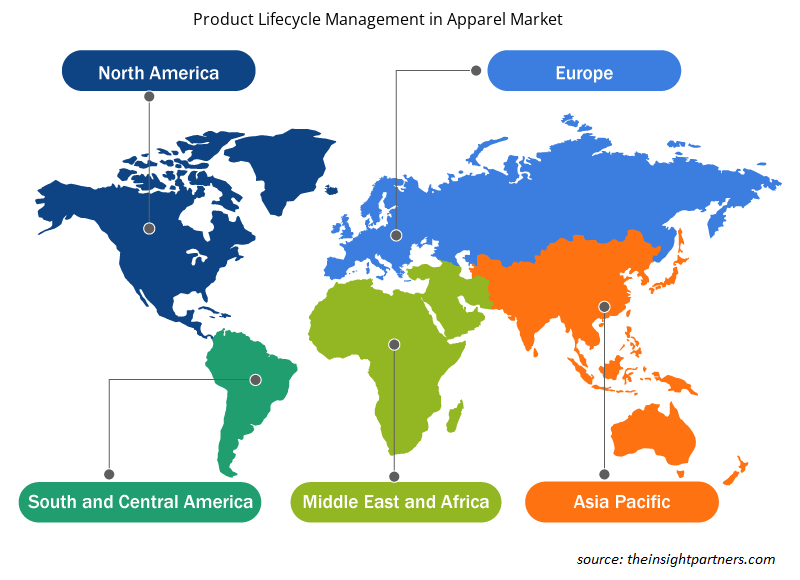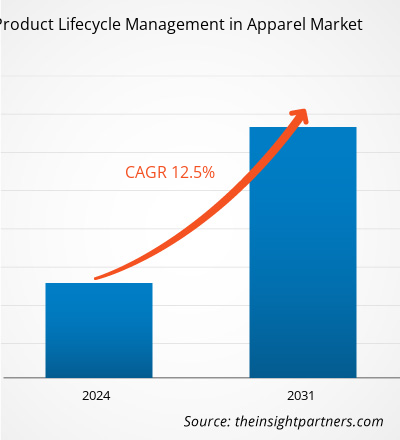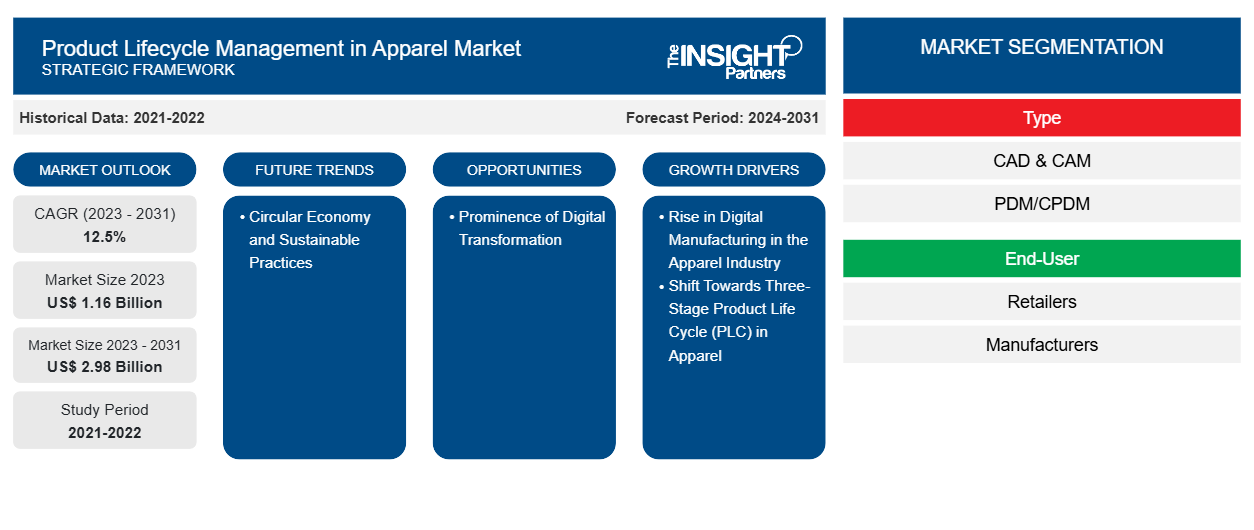Das Marktvolumen für Produktlebenszyklusmanagement im Bekleidungsbereich soll von 1,16 Milliarden US-Dollar im Jahr 2023 auf 2,98 Milliarden US-Dollar im Jahr 2031 anwachsen. Der Markt dürfte zwischen 2023 und 2031 eine durchschnittliche jährliche Wachstumsrate (CAGR) von 12,5 % verzeichnen. Kreislaufwirtschaft und nachhaltige Praktiken sowie die Betonung der digitalen Transformation werden voraussichtlich weiterhin die wichtigsten Trends im Bereich Produktlebenszyklusmanagement im Bekleidungsmarkt bleiben.
Produktlebenszyklusmanagement in der Bekleidungsmarktanalyse
Schnelle Veränderungen im Geschmack der Verbraucher kennzeichnen die Modebranche und die kürzere Produktlebensdauer, was ihre Komplexität noch erhöht. Diese Veränderungen schaffen Schwierigkeiten und Perspektiven in vielen Bereichen des Sektors, wie etwa in der Herstellung, bei Produktionsmethoden, Standards sowie bei Werbe- und Marketingbemühungen.
Produktlebenszyklusmanagement im Bekleidungsmarkt – Überblick
In der Bekleidungsindustrie ist das Product Lifecycle Management (PLM) ein strategischer Ansatz zur Überwachung des gesamten Lebenszyklus eines Produkts, von seinem ersten Entwurf und seiner Entwicklung bis zu seiner offiziellen Markteinführung, Wartung und Entsorgung. Diese umfassende Methode umfasst die Verwaltung aller Aktivitäten im Zusammenhang mit dem Lebenszyklus eines Produkts, wie Herstellung, Marketing und eventuelle Marktrücknahme. Durch den PLM-Ansatz kann die Branche analysieren, wie gut ein Produkt im Laufe der Zeit vom Markt angenommen wird, einschließlich erheblicher Umsatzschwankungen.
Passen Sie diesen Bericht Ihren Anforderungen an
Sie erhalten kostenlos individuelle Anpassungen an jedem Bericht, einschließlich Teilen dieses Berichts oder einer Analyse auf Länderebene, eines Excel-Datenpakets sowie tolle Angebote und Rabatte für Start-ups und Universitäten.
-
Holen Sie sich die wichtigsten Markttrends aus diesem Bericht.Dieses KOSTENLOSE Beispiel umfasst eine Datenanalyse von Markttrends bis hin zu Schätzungen und Prognosen.
Product Lifecycle Management im Bekleidungsmarkt – Treiber und Chancen
Anstieg der digitalen Fertigung in der Bekleidungsindustrie soll den Markt ankurbeln
Der Aufstieg der digitalen Fertigung in der Bekleidungsindustrie wird voraussichtlich erhebliche Auswirkungen auf den Bedarf an robusten und zuverlässigen Produktlebenszyklusmanagementsystemen (PLM) haben. Dies liegt vor allem an den komplexen Prozessen der digitalen Fertigung, einschließlich Konzeption, Design, Planung und Ausführung, die alle den umfassenden Einsatz von PLM- Software wie CAD und CAM erfordern. Infolgedessen wird erwartet, dass der Ausbau der digitalen Fertigung den Bedarf an PLM-Systemen steigern und so den Fortschritt des Produktlebenszyklusmanagements im Bekleidungsmarkt im Prognosezeitraum vorantreiben wird.
Bedeutung der digitalen Transformation
Der kontinuierliche Wandel hin zur Digitalisierung hat neue Wege für Innovationen eröffnet und moderne Technologien wie maschinelles Lernen (ML), künstliche Intelligenz (KI), Robotik und das Internet der Dinge (IoT) integriert, um den Weg in die Ära der vierten industriellen Revolution (Industrie 4.0) zu ebnen. In der Industrie 4.0 ermöglicht die Verschmelzung von Elektronik und Informationstechnologie die nahtlose digitale Integration der physischen, digitalen und biologischen Aspekte des modernen menschlichen Lebens. Dies stellt einen bedeutenden Wandel für die Fertigungsindustrie dar, insbesondere bei der Produktion von Massengütern wie Kleidung und Schuhen, da Industrie 4.0 einen revolutionären Wandel einleitet. digitalization has opened up new avenues for innovation, incorporating advanced technologies such as machine learning (ML), artificial intelligence (AI), robotics, and the Internet of Things (IoT) to lead the way into the era of the fourth industrial revolution (Industry 4.0). In Industry 4.0, the blending of electronics and information technology facilitates the seamless digital integration of the physical, digital, and biological aspects of modern human life. This marks a significant change for the manufacturing industry, particularly in the production of mass-manufactured goods like clothing and footwear, as Industry 4.0 instigates a revolutionary transformation.
Produktlebenszyklusmanagement im Bekleidungsmarktbericht – Segmentierungsanalyse
Wichtige Segmente, die zur Ableitung des Produktlebenszyklusmanagements in der Bekleidungsmarktanalyse beigetragen haben, sind Typ und Endbenutzer.
- Nach Typ ist der Markt in CAD & CAM und PDM/CPDM unterteilt. Das CAD & CAM-Segment hatte im Jahr 2023 einen bedeutenden Marktanteil.
- In Bezug auf die Endverbraucher ist der Markt segmentiert in Einzelhändler,Hersteller und andere. Das Herstellersegment hielt im Jahr 2023 einen erheblichen Marktanteil.
Product Lifecycle Management in der Bekleidung – Marktanteilsanalyse nach geografischer Lage
Der geografische Umfang des Marktberichts zum Produktlebenszyklusmanagement in der Bekleidungsindustrie ist hauptsächlich in fünf Regionen unterteilt: Nordamerika, Asien-Pazifik, Europa, Naher Osten und Afrika sowie Südamerika/Süd- und Mittelamerika.
Das Produktlebenszyklusmanagement im europäischen Bekleidungsmarkt umfasst die Verwaltung des gesamten Lebenszyklus von Modeprodukten und befasst sich mit den besonderen Herausforderungen, die sich durch schnelllebige Trends und Verbraucherpräferenzen ergeben. Es wird erwartet, dass der Markt ein erhebliches Wachstum verzeichnen wird, und die Anpassung an die sich ändernde Marktdynamik bietet Unternehmen der europäischen Bekleidungsindustrie Chancen.
Produktlebenszyklusmanagement im Bekleidungsmarkt – regionale Einblicke
Die regionalen Trends und Faktoren, die das Produktlebenszyklusmanagement im Bekleidungsmarkt während des Prognosezeitraums beeinflussen, wurden von den Analysten von Insight Partners ausführlich erläutert. In diesem Abschnitt werden auch die Marktsegmente und die Geografie des Produktlebenszyklusmanagements im Bekleidungsmarkt in Nordamerika, Europa, im asiatisch-pazifischen Raum, im Nahen Osten und Afrika sowie in Süd- und Mittelamerika erörtert.

- Erhalten Sie regionalspezifische Daten zum Produktlebenszyklusmanagement im Bekleidungsmarkt
Umfang des Marktberichts zum Produktlebenszyklusmanagement in der Bekleidung
| Berichtsattribut | Details |
|---|---|
| Marktgröße im Jahr 2023 | 1,16 Milliarden US-Dollar |
| Marktgröße bis 2031 | 2,98 Milliarden US-Dollar |
| Globale CAGR (2023 - 2031) | 12,5 % |
| Historische Daten | 2021-2022 |
| Prognosezeitraum | 2024–2031 |
| Abgedeckte Segmente |
Nach Typ
|
| Abgedeckte Regionen und Länder |
Nordamerika
|
| Marktführer und wichtige Unternehmensprofile |
|
Marktteilnehmerdichte: Der Einfluss auf die Geschäftsdynamik
Der Markt für Produktlebenszyklusmanagement im Bekleidungsmarkt wächst rasant, angetrieben durch die steigende Nachfrage der Endnutzer aufgrund von Faktoren wie sich entwickelnden Verbraucherpräferenzen, technologischen Fortschritten und einem größeren Bewusstsein für die Vorteile des Produkts. Mit steigender Nachfrage erweitern Unternehmen ihr Angebot, entwickeln Innovationen, um die Bedürfnisse der Verbraucher zu erfüllen, und nutzen neue Trends, was das Marktwachstum weiter ankurbelt.
Die Marktteilnehmerdichte bezieht sich auf die Verteilung der Firmen oder Unternehmen, die in einem bestimmten Markt oder einer bestimmten Branche tätig sind. Sie gibt an, wie viele Wettbewerber (Marktteilnehmer) in einem bestimmten Marktraum im Verhältnis zu seiner Größe oder seinem gesamten Marktwert präsent sind.
Die wichtigsten Unternehmen, die im Bereich Product Lifecycle Management im Bekleidungsmarkt tätig sind, sind:
- C-DESIGN Mode
- Computergenerierte Lösung
- Dassault Systemes
- EFI Optitex
- Gerber Technology LLC
- Infor Inc.
Haftungsausschluss : Die oben aufgeführten Unternehmen sind nicht in einer bestimmten Reihenfolge aufgeführt.

- Überblick über die wichtigsten Akteure des Product Lifecycle Managements im Bekleidungsmarkt
Produktlebenszyklusmanagement im Bekleidungsmarkt – Neuigkeiten und aktuelle Entwicklungen
Das Produktlebenszyklusmanagement im Bekleidungsmarkt wird durch die Erfassung qualitativer und quantitativer Daten nach Primär- und Sekundärforschung bewertet, die wichtige Unternehmensveröffentlichungen, Verbandsdaten und Datenbanken umfasst. Im Folgenden finden Sie eine Liste der Entwicklungen auf dem Markt:
- Aptean, ein globaler Anbieter unternehmenskritischer Unternehmenssoftwarelösungen, gab die Übernahme von Momentis bekannt, einem Anbieter spezieller Softwarelösungen für die Mode-, Bekleidungs-, Schuh-, Textil- und Accessoire-Branche.
(Quelle: Aptean Inc., Pressemitteilung, 2024)
- Infor®, das branchenweite Cloud-Unternehmen, gab heute die Verfügbarkeit einer dedizierten Schnittstelle zwischen Made2Flow, einem auf die Analyse und Validierung von Umweltdaten in der Modebranche spezialisierten Technologieunternehmen, und Infor Product Lifecycle Management (PLM) bekannt. Die Schnittstelle erleichtert die Datenverarbeitung und vollständige Transparenz für globale Modemarken, die die Transparenz der Produktionslieferkette erhöhen möchten. Entscheidend ist, dass sie die Rückverfolgbarkeit und Auswirkungsmessung auf den Ebenen eins bis vier unterstützt.
(Quelle: Infor, Pressemitteilung, 2023)
Bericht zum Product Lifecycle Management im Bekleidungsmarkt – Umfang und Ergebnisse
Der Bericht „Marktgröße und Prognose zum Produktlebenszyklusmanagement in der Bekleidungsindustrie (2021–2031)“ bietet eine detaillierte Analyse des Marktes, die die folgenden Bereiche abdeckt:
- Marktgröße und Prognose auf globaler, regionaler und Länderebene für alle wichtigen Marktsegmente, die im Rahmen des Projekts abgedeckt sind
- Marktdynamik wie Treiber, Beschränkungen und wichtige Chancen
- Wichtige Zukunftstrends
- Detaillierte PEST/Porters Five Forces- und SWOT-Analyse
- Globale und regionale Marktanalyse mit wichtigen Markttrends, wichtigen Akteuren, Vorschriften und aktuellen Marktentwicklungen
- Branchenlandschaft und Wettbewerbsanalyse, einschließlich Marktkonzentration, Heatmap-Analyse, prominenten Akteuren und aktuellen Entwicklungen
- Detaillierte Firmenprofile
- Historische Analyse (2 Jahre), Basisjahr, Prognose (7 Jahre) mit CAGR
- PEST- und SWOT-Analyse
- Marktgröße Wert/Volumen – Global, Regional, Land
- Branchen- und Wettbewerbslandschaft
- Excel-Datensatz
Aktuelle Berichte
Verwandte Berichte
Erfahrungsberichte
Grund zum Kauf
- Fundierte Entscheidungsfindung
- Marktdynamik verstehen
- Wettbewerbsanalyse
- Kundeneinblicke
- Marktprognosen
- Risikominimierung
- Strategische Planung
- Investitionsbegründung
- Identifizierung neuer Märkte
- Verbesserung von Marketingstrategien
- Steigerung der Betriebseffizienz
- Anpassung an regulatorische Trends























 Kostenlose Probe anfordern für - Produktlebenszyklusmanagement im Bekleidungsmarkt
Kostenlose Probe anfordern für - Produktlebenszyklusmanagement im Bekleidungsmarkt